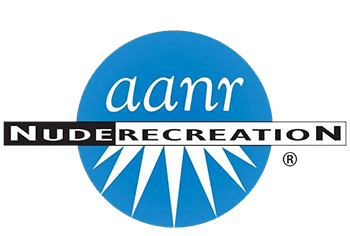
Body Acceptance
Body acceptance is a core tenet of nude recreation – the notion of welcoming everyone regardless of weight, tattoos, piercings, hair color, surgical scars, and other imperfections. Ironically, accepting the bodies of others can be less challenging than embracing one’s own physical imperfections, visible as they are upon looking in the mirror. People tend to be their own worst critics, magnifying flaws that others might not notice, and this can lead to poor body image and low self-esteem.
Not surprisingly, the most popular New Year’s resolution is to lose weight. It’s a noble goal, though many fail in that pursuit because they’re motivated more by looking better in a swimsuit or birthday suit than by having greater energy and longer lifespans. There’s perhaps nothing more motivating than the prospect of dying young from poor choices.
For this New Year, think of a resolution not in terms of losing weight, but rather by embracing one’s body regardless of age and imperfections and making the most of it. Most people put far more effort into maintaining a car in the hopes of getting it to 100,000 miles than they do in taking care of a body that could reach 100 years.
Here are four things to consider in making a New Year’s resolution of body acceptance successful.
Accept Changes in Appearance

Some people manage to look 40 forever. But not everyone is Bob Costas or Michelle Pfeiffer. Most people lose hair or see it turn gray, as well as lose lean body mass as they get older. There’s nothing wrong with taking measures to retain a younger appearance. But that’s a losing battle since nobody outlasts Father Time.
Instead, let’s think in terms of making the most of one’s body at any age. This involves strength training, which retains the lean mass that’s naturally lost at the rate of a pound a year after the age of 40. Activities such as swimming, hiking, bicycling, and sports also keep the body looking good and functioning well, warding off the effects of age.
Accept Changes In Metabolism

Some teenagers and young adults can get away with eating mostly junk food and retain a lean appearance, at least on the outside. Most everyone else must make nutritional changes. An active way of life can keep the metabolism burning hot well into middle age, but it’s important to eat a healthier diet of whole foods – including fruits and vegetables, whole grains, fish, and lean meats.
Eating healthy is more a matter of planning than willpower. By planning meals ahead of time, it’s easier to stick with a healthy nutritional program. Nobody eats healthy when they’re hungry and fast food is the only option. Because of technology, it’s easy to track one’s cholesterol and other health data online. A diet rich in berries, nuts, avocado, fish, and olive oil lowers cholesterol, which is a big risk factor for heart disease.
Accept the Seasons of Life

Not every sport is meant to be a lifelong endeavor. This is seen at nudist clubs where former volleyball players shift to water volleyball, tennis players embrace pickleball, and distance runners focus more on walking, swimming, biking, or inline skating. That’s because middle-aged and senior-aged joints don’t respond as well to high-impact sports like volleyball, basketball, and tennis.
It’s possible to play those sports into the senior years, but there’s nothing wrong with taking up a lower impact sport that’s every bit as competitive, fun, and effective in keeping a body functional and fit well into the senior years.
Accept the Role of Coach And Mentor
There’s not a more fulfilling role in life than that of coach and mentor. Parents and teachers know this. But anyone can become a coach and mentor, sharing life experiences with younger and more inexperienced folks. This is especially true in sports, fitness, and dance. Long after one’s competitive career is over, it’s possible to draw from a lifetime of experiences to help others succeed.
-Author Pete Williams http://www.tolivelean.com/

